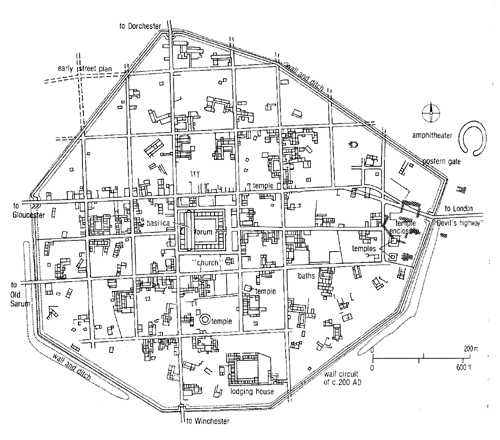|
Roman Towns
The Romans arrived in Britain in 43AD. They had visited before, when Julius Caesar invaded and fought several battles about 100 years earlier. But this time they came to stay. They built lots of towns on the model that was used throughout their vast empire. These were unlike anything the Celts had seen before - they had stone and brick buildings, fancy structures like theatres, temples, and amphitheatres, and huge shopping and market areas in the centre. Some better off Celts moved into these towns and had much larger and more comfortable accommodation than in their villages. As you look at these web pages, try to imagine how different life would have been for one of these Celts moving from country to town.
The Beginnings of Roman Towns
Some towns grew up outside of army camps, to provide the soldiers with shopping, taverns, and women. Soldiers were not supposed to marry and have children but many did, and this was accepted. The children were allowed to become Roman citizens - if they joined the army!
Some Roman towns were specially built. One type was a 'colonia' - a town for retired soldiers. Colchester was one of these settlements of army veterans. London grew up as the seat of government - the Roman governor of Britain ruled from there, and London was the capital of Britain as it still is today.
St. Albans, a Roman town to the north of London, was originally the capital of a Celtic tribe, the Catevellauni. Iceni Ventorum in Norfolk (now known as Caistor) was the capital of the Iceni tribe. After the Iceni rebelled under their queen Boudicca, the Romans destroyed their town and rebuilt it in the Roman style.
|
Caistor (near Norwich). Known as Venta Icenorum by the Romans. |
|
Reconstruction of Canterbury (theatre and baths at the back) |
|
|
What were Roman Towns Like?
Roman towns were planned by expert town planners (or military engineers) and were laid out in a very regular chessboard-like pattern. Streets crossed each other and made lots of blocks known as 'insulae'. Houses, shops and so on lined these streets. In the centre were the most important buildings - the basilica (town hall) and forum (market place). In most towns there were also temples to Roman gods (and sometimes Celtic gods), and outside the town an amphitheatre for entertainment. Some towns also had theatres for less bloody amusement.
When Roman towns were first built there was usually only an earth ramp and wooden fence to protect the town, as with Celtic hill forts. In the 3rd century stone walls, towers, and gates were built for better defence.
On this page you can see some reconstructions and maps of Roman towns in Britain and elsewhere. Towns are much better preserved in other countries, so here you will also see photos of Pompeii (in Italy) and Timgad (in Algeria).
|
Reconstruction of Silchester, showing forum and basilica (back centre), cattle market and houses and shops |
|
View of Silchester, showing city wall and plan of streets. |
Map of Silchester
|
|
A street in Pompeii |
Pompeii - forum in the middle
|
|
Map of Timgad, showing main buildings |
 Timgad, in Algeria. One of the most regular Roman towns, it is almost square. |
|
Reconstruction of street in Pompeii, showing a temple. |
 Aosta in Italy, another very regular town. Unusually the theatre is under a roof (the tall building to the right) and the amphitheatre is inside the city walls. |








